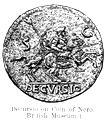Decursio, Decursus, Decurrere
1.
These words were used to signify the manœuvres of the Roman army, by which the
soldiers were taught to make long marches in a given time, under arms and without quitting
their ranks. They are frequently mentioned by Livy , and sometimes consisted of a sham fight
between two divisions of the army (
Liv. xl. 6, 5). With the
standing armies under the Empire these manœuvres assumed a more regular form, and
were constantly practised. Augustus and subsequently Hadrian ordered that the infantry and
cavalry were to march out three times a month ten miles from the camp and ten miles back,
fully armed and equipped. This is called by Vegetius
campicursio (Veget.
i. 27, iii. 4), and by Suetonius
campestris decursio (
Galb. 6).
2.
The same words were used to signify the military honours paid by soldiers at the funerals
 |
|
Decursio on Coin of Nero. (British Museum.)
|
of distinguished generals or emperors. Such a decursio is first mentioned in
connection with the funeral of Sempronius Gracchus, killed in the Second Punic War (
Liv. xxv. 17, 4,
5). The soldiers marched three times around the funeral pyre (
Verg. Aen. xi. 188;
Tac.
Ann. ii. 7;
Claud. 1).
3.
The decursio, which occurs on the coins of Nero, probably refers to the military
manœuvres or sham fights in the circus. The above cut represents a horseman with a
spear, and another carrying a standard. These games date from the time of the Republic and
were continued under the Empire (
Liv. xliv. 9, 3).





